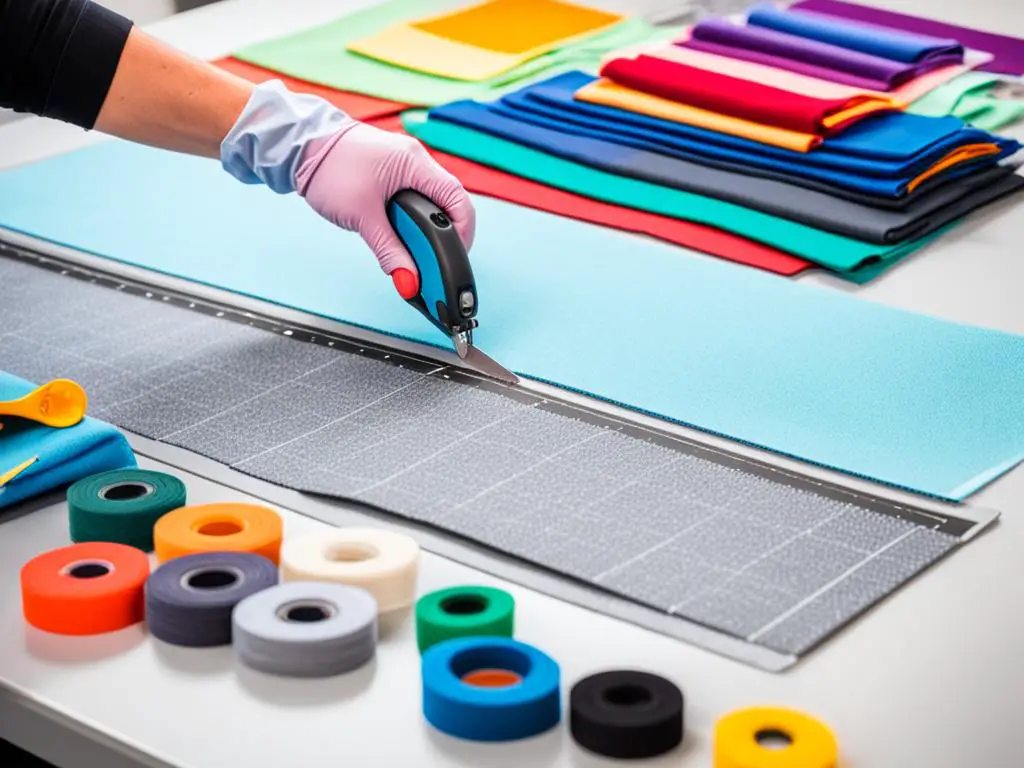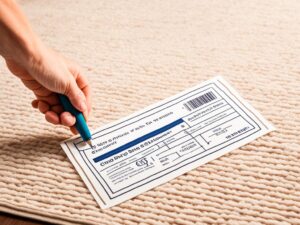Welcome to our DIY guide on how to cut a rug! If you have a rug that needs resizing or want to repurpose an old one, you’ve come to the right place. In this tutorial, we will provide you with step-by-step instructions, useful tips, and techniques to help you cut a rug with ease and precision. Whether you’re a beginner or have some DIY experience, this guide will walk you through the process and equip you with the necessary knowledge to achieve professional-looking results.
Key Takeaways:
- Learn how to cut a rug to resize it and repurpose old rugs.
- Discover the necessary supplies and tools for rug cutting.
- Explore techniques to prevent fraying and achieve clean-cut edges.
- Understand the benefits of resizing a rug and saving money compared to buying a new one.
- Follow safety precautions and take your time to ensure precise results.
How to Cut a Rug to Resize It
When it comes to resizing a rug, you don’t have to rely on professional services or spend a fortune. With the right techniques and tools, you can easily cut a rug to the perfect size right in the comfort of your own home. In this section, we will guide you through the step-by-step process of cutting a rug to resize it, ensuring precise results every time.
To begin, gather the necessary supplies for rug cutting. You will need Instabind, a durable binding solution, as well as a piece of wood or cardboard to protect your flooring and a sharp utility knife for the cutting process. These tools will allow you to achieve clean and accurate cuts without damaging your rug or the surrounding area.
Once you have your supplies ready, it’s time to measure and mark the rug. Use a measuring tape to determine the desired size of your rug, taking into account the specific area you want to fit. Mark the measurements on the rug using a fabric pen or chalk, ensuring clear and visible lines for cutting.
Now comes the exciting part – actually cutting the rug! Carefully align your utility knife with the marked lines and make a series of small, controlled cuts. Take your time and apply steady pressure to ensure smooth and precise cuts. Remember, it’s always better to trim the rug conservatively and make additional adjustments if needed than to cut too much at once.
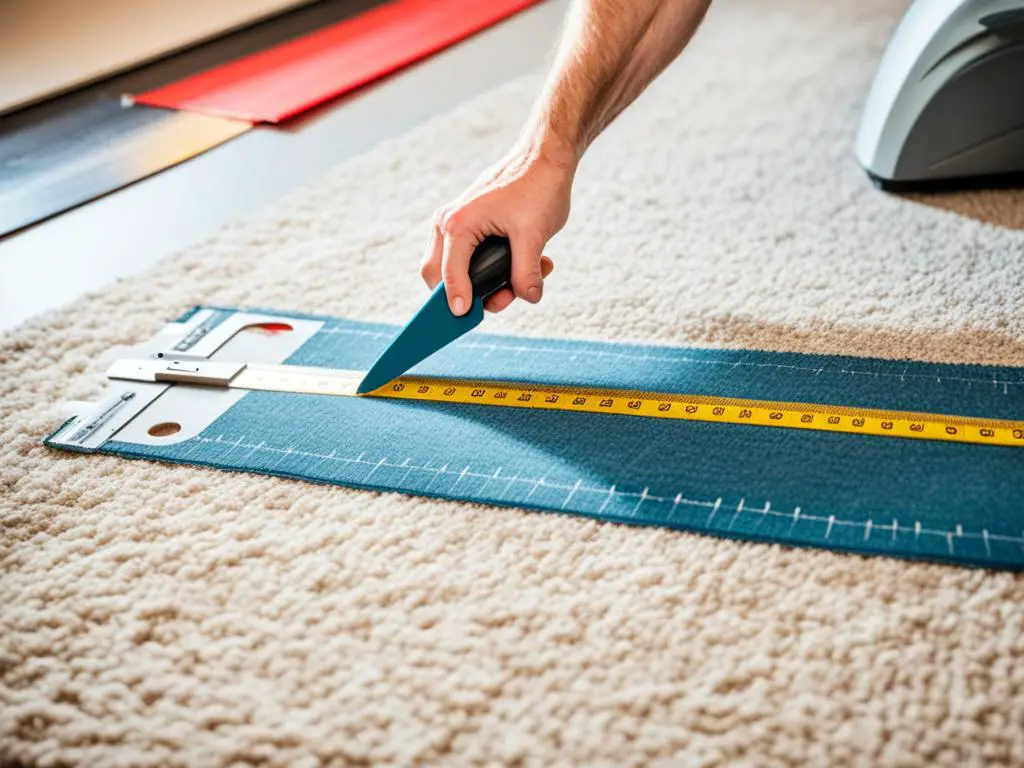
After you have cut the rug to the desired size, it’s important to finish the cut edges to prevent fraying. This is where Instabind comes in handy. Apply the binding tape to the cut edges, following the manufacturer’s instructions. The binding tape will secure the edges and create a clean and professional-looking finish, preventing the rug from unraveling over time.
Once the binding is in place, you can trim any excess tape and smooth out any wrinkles or bulges for a seamless and polished appearance. Use a hot glue gun to secure the binding and ensure it stays in place. Be cautious when using hot glue and follow safety precautions to avoid burns or damages.
Cutting a Rug: Step-by-Step Summary
- Gather necessary supplies: Instabind, wood or cardboard, and a utility knife.
- Measure and mark the rug according to the desired size.
- Cut the rug along the marked lines using a sharp utility knife.
- Apply Instabind to the cut edges to prevent fraying.
- Trim excess binding tape and secure with a hot glue gun.
By following these simple steps, even beginners can successfully cut a rug to resize it. Whether you want to transform an old rug or customize the size to fit a specific space, DIY rug cutting offers a cost-effective and rewarding solution. Get ready to unleash your creativity and enjoy a customized rug that perfectly complements your home!
Tips for Cutting a Rug Without Fraying
When it comes to rug cutting, preventing fraying is essential for achieving clean and professional-looking results. Here are some techniques and tips to help you cut a rug without any fraying:
1. Use a sharp razor blade or utility knife
Using a sharp cutting tool is crucial for clean and precise cuts. A dull blade can cause the rug fibers to pull and fray. Ensure your blade is sharp before starting the cutting process.
2. Take safety precautions
Before you begin cutting the rug, it’s important to prioritize safety. Wear gloves to protect your hands from potential cuts or injuries. Additionally, make sure you have a stable and well-lit work area to avoid accidents.
3. Prevent rug fibers from coming loose
To prevent the rug fibers from unraveling during the cutting process, try lightly taping the area you intend to cut with masking or painter’s tape. This can help hold the fibers in place and reduce the risk of fraying.
4. Utilize rug binding tape
Rug binding tape is a helpful tool for securing the cut edges of the rug and preventing fraying. It provides a clean and finished look to your rug. Apply the tape along the cut edge and press firmly to ensure it adheres securely.
5. Secure the cut edges with hot glue
In addition to rug binding tape, applying hot glue can further reinforce the cut edges and prevent fraying. Carefully apply a thin line of hot glue along the cut edge and press the binding tape onto the glue. Be cautious when handling the hot glue gun to avoid burns.
By following these tips, you can cut a rug without worrying about fraying. Remember to use a sharp blade, take safety precautions, and utilize rug binding tape and hot glue to secure the cut edges. With the right techniques, you can achieve a clean and professional finish.
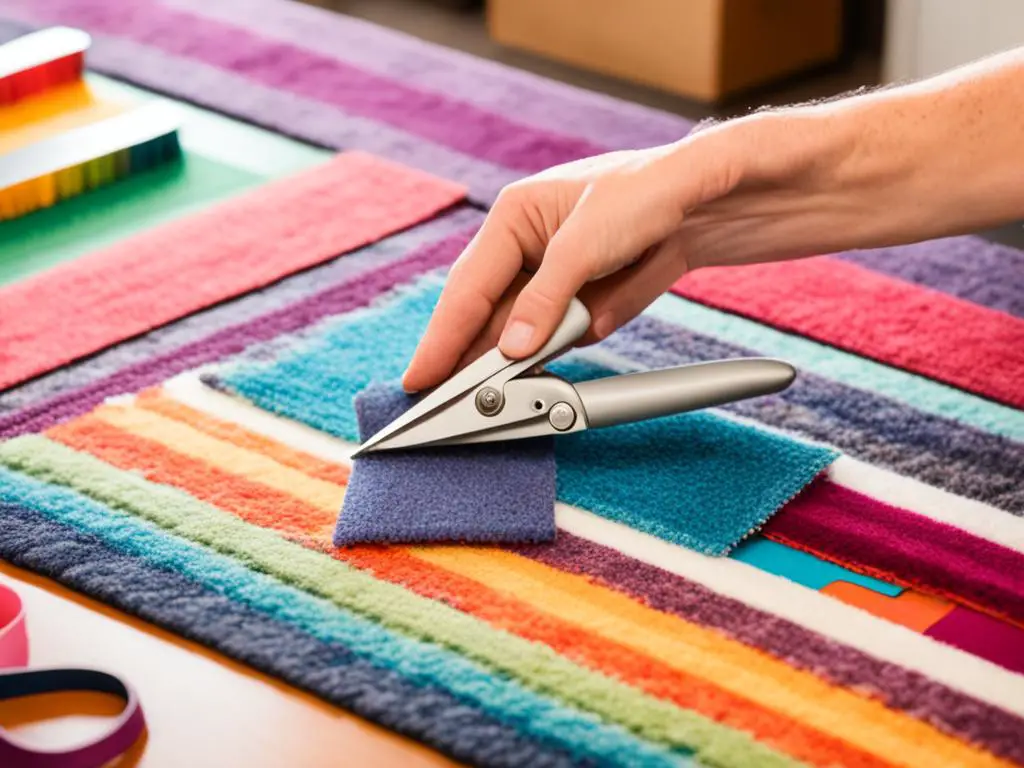
Reasons to Resize a Rug
Resizing a rug can offer numerous benefits and practical advantages. Whether you have an oversized rug that doesn’t quite fit your space, or an old rug that needs a new purpose, rug resizing can provide an ideal solution. Here are some compelling reasons to consider resizing your rug:
1. Customization and Proper Fit
One of the main reasons to resize a rug is to customize it according to your specific space. By cutting and resizing the rug, you can achieve a perfect fit that enhances the aesthetics of your room. Whether you want to highlight a particular area or create a cohesive look, resizing the rug allows you to tailor it to your exact needs.
2. Repurposing Old Rugs
Do you have an old rug that no longer serves its original purpose? Instead of discarding it or storing it away, you can repurpose the rug by resizing it. By cutting the rug to a new size, you can transform it into a stylish accent rug, doormat, or even smaller area rugs for different parts of your home. It’s a great way to breathe new life into an old rug and give it a fresh purpose.
3. Cost Savings
If you’re looking to update your home decor on a budget, resizing a rug can be a cost-effective alternative to purchasing a new one. Rather than investing in an entirely new rug, resizing allows you to make use of what you already have. This not only saves you money but also reduces waste by repurposing existing materials.
Resizing a rug gives you the flexibility to adapt and modify your rug collection according to your evolving needs and preferences. Whether you’re looking to create a custom fit, repurpose an old rug, or save money, resizing a rug is a practical and rewarding DIY project.
Image:
Tools and Equipment for Rug Cutting
When it comes to cutting a rug, having the right tools and equipment is crucial for achieving precise and professional results. Whether you’re a beginner or an experienced DIY enthusiast, here are some essential items you’ll need:
1. Utility Knife
A high-quality utility knife is a must-have tool for cutting rugs. Look for one with a sharp blade that can easily cut through the rug fibers without fraying or snagging.
2. Straight Edge
To ensure straight and accurate cuts, use a straight edge as a guide. This can be a ruler, a T-square, or a specialized rug cutting tool. It will help you maintain a clean and even line throughout the cutting process.
3. Hot Glue Gun
Hot glue is an excellent adhesive for securing the cut edges of the rug and preventing fraying. Invest in a reliable hot glue gun that provides a steady and consistent flow of glue.
4. Measuring Tape
Accurate measurements are essential when cutting a rug. A measuring tape will help you determine the desired size and ensure your cuts are precise. Make sure to measure twice and cut once to avoid any mistakes.
5. Wood or Cardboard
Protect your floor while cutting the rug by placing a piece of wood or cardboard underneath. This will prevent damage to the surface and provide stability as you make your cuts.
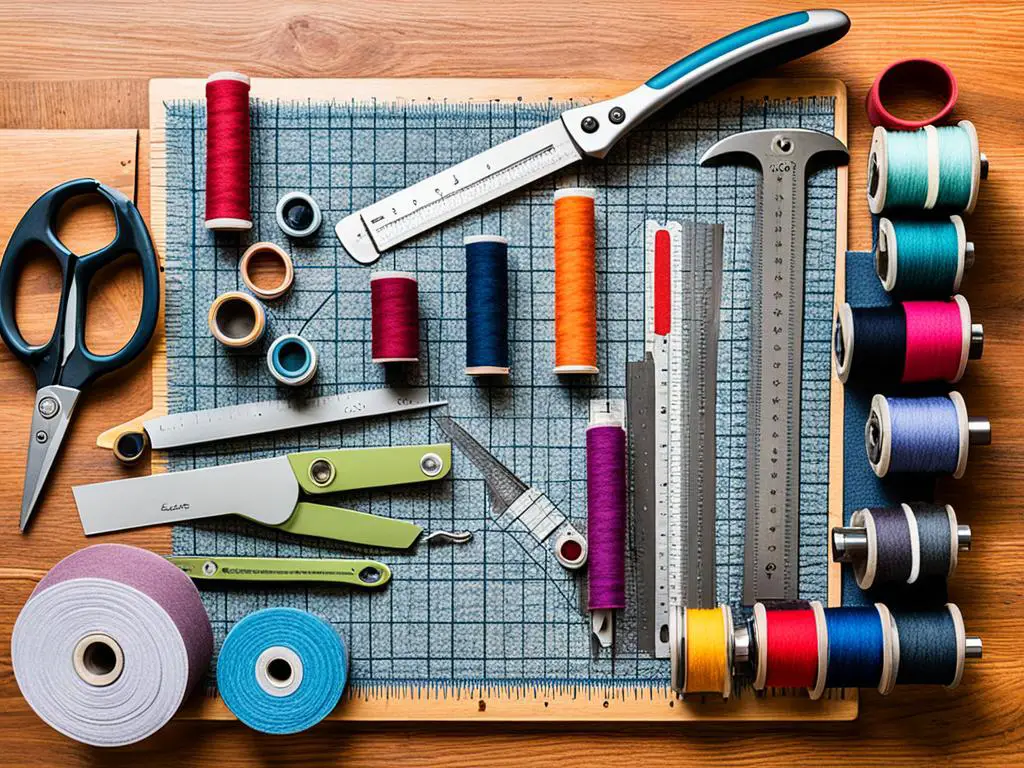
These tools can be easily sourced from local hardware stores or online retailers. Additionally, you may want to consider using Instabind, a specialized binding tape, to secure the cut edges of the rug and give it a finished look.
Preparing the Rug for Cutting
Before you begin cutting your rug, it’s important to properly prepare it. This will ensure that the cutting process goes smoothly and that you achieve the desired results. Follow these steps to prepare your rug for cutting:
- Clean the rug: Start by thoroughly cleaning the rug. Use a vacuum cleaner to remove any loose dirt or debris from the surface. If there are any stains on the rug, treat them accordingly using a suitable carpet cleaner. Cleaning the rug will not only make it easier to handle but also prevent any dirt or stains from spreading during the cutting process.
- Remove wrinkles and creases: Lay the rug flat on a clean, level surface. If the rug has any wrinkles or creases, gently stretch or press them out to ensure a smooth and even surface. This will help you achieve accurate measurements and cuts.
- Secure the rug: It’s crucial to work on a stable and secure surface to prevent the rug from shifting or moving during the cutting process. Use heavy objects or carpet tape to anchor the corners or edges of the rug to the floor. This will keep it in place and help maintain the desired shape and size as you cut.
By following these steps, you’ll ensure that your rug is clean, wrinkle-free, and securely positioned before you start cutting. This will set the foundation for a successful and precise rug-cutting process.
Cutting Techniques and Finishing the Rug
When it comes to cutting a rug, it’s important to use the right techniques to achieve a clean and professional finish. Whether you’re working with a flat weave or a thick shag rug, the following steps will guide you through the process.
Cutting Techniques
To begin, gather a sharp razor blade or utility knife to cut through the rug’s base and fabric. Start by placing a straight edge or ruler along the marked cutting line to ensure a straight cut. Apply gentle, controlled pressure as you slowly cut through the rug, making sure to follow your marked line.
For flat weave rugs, it’s best to cut with the fabric’s grain to minimize fraying. If you’re working with a shag or high-pile rug, use a longer blade to penetrate through the dense fibers smoothly.
Remember to take safety precautions during the cutting process. Always keep your fingers away from the blade and work in a well-ventilated area to avoid inhaling any particles released during cutting.
Finishing the Rug
To give your cut rug a polished look and prevent fraying, finishing the edges is essential. Edge binding is a popular method to achieve this. Start by selecting a binding material that complements your rug’s color and texture. Common options include cotton binding tape, leather, or faux suede.
Secure the binding material to the rug’s edge using a hot glue gun or fabric adhesive. Apply the glue or adhesive evenly along the cut edge, then press the binding onto it firmly. Work in small sections to ensure a secure attachment.
Trim any excess binding material and press the cut edge down to seal it. This will prevent any loose threads from unraveling. Allow the glue or adhesive to dry completely before handling the rug.
Rug Cutting Techniques and Finishing Steps
| Step | Rug Cutting Techniques and Finishing Steps |
|---|---|
| 1 | Measure and mark the cutting line on the rug. |
| 2 | Place a straight edge or ruler along the marked line. |
| 3 | Use a sharp razor blade or utility knife to cut through the rug’s base and fabric. |
| 4 | For flat weave rugs, cut with the fabric’s grain to minimize fraying. |
| 5 | For shag or high-pile rugs, use a longer blade to penetrate dense fibers smoothly. |
| 6 | Select a binding material, such as cotton binding tape or leather. |
| 7 | Secure the binding material to the cut edge using a hot glue gun or fabric adhesive. |
| 8 | Trim any excess binding material and press the cut edge down to seal it. |
Conclusion
Cutting a rug to resize it is a rewarding and cost-effective DIY project that can easily be done at home. With the right tools and instructions, you can achieve precise and professional-looking results. Whether you’re repurposing an old rug or customizing the size to fit a specific space, DIY rug cutting offers a practical solution.
By following the step-by-step guide and taking the necessary precautions, you can transform your rug to meet your needs. From measuring and marking the rug to trimming and finishing the edges, each stage of the process is important for achieving a clean and polished result.
With DIY rug cutting, you have the opportunity to unleash your creativity and make your rug truly unique. Whether you’re a beginner or have some experience with DIY projects, cutting rugs at home is a satisfying endeavor that allows you to personalize your space and add your own touch to your décor.
